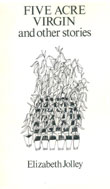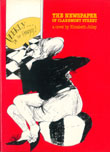

Courtesy of Fremantle Press
... Though often rejected, Jolley learned, as she said in an interview with Ray Willbanks, a sense of avocation, a commitment to writing in the face of the “disaster” of repeated rejections. ...

Courtesy Fremantle Press
... in 1972 the Fremantle Arts Centre was established with a charter to foster the work of Western Australia artists and writers, and subsequently in 1976 the Fremantle Arts Centre Press was founded with the mission of serving as a non-profit regional publisher and distributor. ...
A Regional Career
Jolley sought to be professionally published from the outset-she told one interviewer, Paul Kavanaugh, that “I would never have published anything myself, ever.” After arriving in Australia she submitted to all possible professional outlets. In the mid 1960s and early 1970s she circulated various versions of George's Wife, The Feast of Life, The Leila Family, Palomino, Mr Scobie's Riddle and The Newspaper of Claremont Street (as well as at least five differently structured collections of short stories) to some thirteen publishers in Australia and England. To illustrate, she submitted versions of Palomino to eight publishers, and drafts of Mr Scobie's Riddle and Newspaper of Claremont Street each to seven publishers. Success was nil until Palomino shared the Con Weickhardt Prize for an Unpublished Novel in the 1974 Fellowship of Australian Writers (Victoria) Moomba competition. Little wonder, then, that Jolley was grateful to the London Macmillan representative who spent an entire day with her in 1966 (when in England accompanying her husband on his sabbatical) and told her that, though her manuscript was unpublishable, she had talent as a writer.
During the 1960s/1970s Jolley also wrote and rewrote, and submitted and
resubmitted, short stories, most of which are now familiar from her five
published short-story collections and her collection of radio plays. She
sent stories to literary competitions, to anthologies, and to reigning
literary magazines in Australia but also overseas. She sent script versions
of stories to the British Broadcasting Corporation's World Service,
the Australian Broadcasting Corporation in Perth and Sydney, and, in 1969,
to Richard Attenborough at Woodfell Films and to the Film Corporation
in Melbourne. She also sent stories to newspapers and women's magazines,
including People, Reader's Digest and Tom's
Weekly.
The history of “Hilda's Wedding”—one of Jolley's
best short stories, though not in print until included in Woman in
a Lampshade (1983)—illustrates Jolley's determination to
be published. Over more than a decade, short or long versions were submitted
to Macmillan's Summer's Tales and its Winter's
Tales, to the 1965 Melbourne Festival Competition, to Argosy,
to the agent A. P. Watt, to the publishers Walter King, Nelson, and Gollancz,
to the 1968 Coast to Coast and still another Western Australian
anthology, to London Magazine, to a 1968 Woman's Weekly
short-story competition (and eight years later to the magazine itself),
to the Australian literary journals Tabloid Story and Pol (twice),
to the overseas literary journals Listener, Nova and The
New Yorker, to the 1970 and 1971 Moomba Festival competitions, to
the Victorian Fellowship of Australian Writer's 1977 Alan Marshall
Award competition, and to the ABC—the first time in 1968 and then
again nearly decade later. The ABC broadcast “Hilda's Wedding”
in January 1976.
The story of the long progress of “Hilda's Wedding” toward
being broadcast and published can be understood in more than one way.
Though often rejected, Jolley learned, as she said in an interview with
Ray Willbanks, a sense of avocation, a commitment to writing in the face
of the “disaster” of repeated rejections: in more than one interview
she recalls that in one year during the sixties she received 39 rejections.
But, equally, Jolley learned a sense of vocation, a canny determination
not only to write her own way but also to find access to the literary
infrastructure of a particular time and place.
Jolley found publishing, as she said in an interview with Candida Baker,
“a slow, hard business from Western Australia.” From her position
as a “new Australian” living in Western Australia, it seemed
to her that Paul Carter's 1940s/1950s republican nationalist paradigm
or the 1950s/1960s modernist-plus-Australian-local-colour paradigm still
held sway. So, as she said in conversation with Barbara Milech, she gave
“an Australian character” to some of the stories she brought
with her from Scotland-she gave them gum nuts and goannas, and themes
of Australian struggles. At the same time she located new stories, many
about migrants, in an Australian setting, and imagined potently symbolic
Australian landscapes for the novels she (re)worked on across these years—Palomino,
Mr Scobie's Riddle and Milk and Honey.
Giving an Australian quality to the stories she submitted across the 1960s,
many of which found publication in the 1970s, was perhaps Jolley's
best strategy, given her time and place. For, fundamentally, her writing
could not easily be assimilated to the different sorts of “new writing”
that stormed the Australian stage in the late sixties and early seventies:
for example, it exhibited none of the ocker nationalism of David Williamson,
Jack Hibberd and others associated with Melbourne's La Mama Theatre,
established in 1967; and her exploration of unconventional sexualities
had little in common with what Michael Wilding called an “onslaught
on bourgeois sexual repression” by the young men of Sydney—including
Frank Moorhouse and Wilding himself—through their Sydney-based Tabloid
venture, inaugurated in 1972. Not surprisingly, then, Jolley found the
“slow, hard business” of publishing somehow related to the fact
that those who governed access to publishing were largely Eastern-based
and had little interest in literary offerings from the West. But she persisted.
Jolley's first success in Australia was in radio. The BBC World Service
first broadcast her stories as radio plays (two in the sixties and eight
in the seventies), and from 1975 through 1980 the ABC broadcast five of
the nine radio plays included in Off the Air: Nine Plays for Radio
by Elizabeth Jolley. At the same time, 17 stories found their way
into print, nearly half in Western Australian journals and anthologies.
Thus it was the local Westerly which in 1967 published her second
and third print stories-“A Hedge of Rosemary” and “The
Rhyme,” both first written in Scotland and then retrofitted with
an Australian setting. In the previous year “A Hedge of Rosemary”
had won Jolley the first of her many literary prizes-the Fellowship of
Australian Writers' (Victoria) Moomba Short Story Award. And, at
the end of this period, Jolley received two more Moomba short-story awards—for
“Running on the Spot” in 1980 and “The Libation” in
1981 (together with prizes for two other short stories). Given this and
her earlier 1974 Moomba shared prize for an unpublished manuscript, it
makes sense that, when Milech asked what one thing made her career possible,
she replied “the Moomba prizes.”
But it was not simply the prizes that enabled Jolley finally to establish
herself during the mid to late 1970s. To borrow from an alternate title
of one of her essays, “Butchers and Bilberry Baskets,” equally
it was the “miracle of confluence” of three developments in
Australia of that time. First, nationally, there was the miracle of the
new levels of arts funding under the Whitlam Labor government (1972-1975).
It replaced the Australian Council for the Arts with the Australia Council,
and the latter's Literature Board (one of seven new Boards) dispersed
grants to individuals, publishers and organisations from 1973 onwards
(even though the statutory act that invested the Council was not passed
until 1975). Second, regionally, in 1972 the Fremantle Arts Centre was
established with a charter to foster the work of Western Australia artists
and writers, and subsequently in 1976 the Fremantle Arts Centre Press
was founded with the mission of serving as a non-profit regional publisher
and distributor.
These two developments were interdependent, as witnessed by the federal
subsidies for the FACP publication of Jolley's first two collections
of short stories in the seventies, and its publication of two of her early
novels in the early 1980s (The Newspaper of Claremont Street and
Milk and Honey). Comparably, in 1980 the Literature Board subsidised
the publication of Palomino by Outback Press, and in 1983 the publication
of Miss Peabody's Inheritance by the University of Queensland
Press and Mr Scobie's Riddle and Woman in a Lampshade
by Penguin. This record of federal subsidies is a measure of the large
impact of the new government patronage on the writing life in Australia
in the 1970s/1980s.
And then there was a third national/regional circumstance that contributed
to the “miracle of confluence” that shaped Jolley's career
in the seventies-the Australia-wide recognition and institutionalisation
of both Creative Writing and Australian Studies as disciplinary studies.
In Western Australia, for example, the Fremantle Arts Centre ran creative-writing
programs at the Centre and also creative-writing workshops and book clubs
in country centres though its Arts Access program. And in the same period
the Department of English at the Western Australian Institute of Technology
(one of the new Colleges of Advanced Education which, along with the new
universities, were established from the late 1960s onwards) set up three-year
undergraduate majors in both Creative Writing and Australian Studies.
These developments directly impacted on Jolley's career. In 1974
she began teaching at the Fremantle Arts Centre, in both its Perth courses
and its country workshops (the same year she received the Victorian FAW
Prize for an unpublished manuscript). And in 1978 she began teaching creative-writing
classes at the Western Australian Institute of Technology (now Curtin
University of Technology), where she taught until she retired as Emeritus
Professor of Creative Writing in 2002.